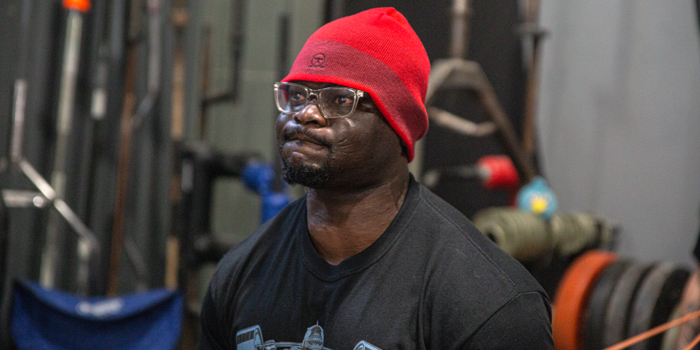
To perform your best on meet day, do the minimum. Sounds lazy, I know. After weeks and weeks of grinding away and training hard, it certainly does seem counterintuitive. Heed my advice—do the bare minimum for meet day success.
Do the Minimum in the Warm-Up Room
This one is pretty simple. Do as little as humanly possible in the warm-up room. Before taking the platform, you should do just enough to be ready, primed, and warmed up to take that opening attempt.
Sets and Reps
In very basic terms, do less. There is no benefit to doing a bunch of high rep sets, nor many benefits to small jumps in between sets. Of course, each lifter will be different, and all of this is dependent on strength level. If you are capable of taking plate jumps, then do it! Maybe 90 pounds at a time is too much, but conceptually this applies to all. Take the largest jumps in between sets that you are comfortable taking with the least amount of reps. Minimize the overall warm-up room workload as much as possible.
Effort
Most lifters have probably seen this guy. He's the guy in the back that absolutely blasts light weights during warm-ups. The squat bar jumps off his back, his whole body bounces on the bench, and deadlifts look like he's trying to clean the weight. Although this is all great for the ego, it's bad for performance. Think of it like this: at the beginning of the day, you have a full tank of gas. Every rep you take depletes your tank a little bit. Going ballistic on warm-up weights is like going full throttle after every red light. You are sucking the gas tank dry! And for what? The warm-up room doesn’t count. There are no bonus points for how fast you move 315 in the back. Hold back a little bit and save that extra gear and power for the platform.
Do the Minimum to Get Your Total
This topic is all about risk mitigation. At the beginning of the day, you have a goal that I think probably fits in one of three categories. Your top priority is likely to win the meet, post a PR total, or post a qualifying total. Getting all three would be great, but for most meets, one of those three is the most important minimum to hit.
Posting a Qualifying Total
Suppose you have a lifter that needs to hit a 1600-pound total to qualify for a bigger meet that they want to do. This lifter squats and deadlifts a little over 600 pounds and benches right about 400. That total is well within their reach and with a decent day, they should hit it.
RECENT: Transitioning from Raw to Gear and Back Again
Here's a scenario: A lifter is selecting their third attempt squat. He just hit 580 and it went pretty well. A PR squat of 620 is possible! Perhaps a bit of a stretch, but it is possible. Should he go for it? Nope. If he misses 620 and is stuck with 580, that qualifying total starts to become out of reach. With a 580 squat, he needs a perfect bench and a big deadlift to get 1600. Do the minimum! Take 605, an almost guaranteed attempt, and set up an easier path to the total needed.
Winning the Meet or Posting a PR Total
Conceptually, I look at this scenario the same as getting the qualifier. It's all about subordinating the ego a bit and making the right call to get the goal accomplished.
Let’s use another example to illustrate: This time it comes down to the last deadlift. You know that you can put the win out of reach for the next guy (or post a PR total) with a deadlift that is 15 pounds under your best pull. But the second attempt went really well! The PR pull, win and PR total are all within reach if you can just hit the big pull. Don’t do it. Do the minimum. Let’s say you went big and missed. Now the PR total is gone. The PR deadlift is gone. And the second-place guy? He now has an easy path to beat you and steal the meet out from under you. Do the minimum and secure the most important goal, the win.
Emotionally, Do the Minimum
I look at the emotional energy at meets in the same way I think about warming up. At the start of the day, you have a full tank of gas. Getting super hyped up depletes that fuel. At every meet, you will find the lifter that has headphones on the whole day and stays hyper-stimulated from the moment they arrive until the last deadlift is pulled. Staying in a highly aroused state takes a lot of energy! While it might not be actually lifting, behaving this way still drains you.
Yet again, do the minimum. There is a time and place to get amped up and use some emotion to fuel a lift. That time is not in the warm-up room and definitely not on the first couple of warm-up sets. This is a waste of energy. Managing emotional energy isn’t easy and will take some training. I wouldn’t tell a lifter to make this change on the spot. I think it takes time to learn how to “flip the switch” and be able to get up at the right time. Integrate this into your training by controlling emotions in the gym and saving your energy for only the biggest lifts. Maybe you need a trigger to get the switch flipped. Find it and utilize that extra boost when it matters most.
On meet day, less effort exerted off the platform will almost certainly lead to better performance—whether it be in the warm-up room, waiting for your attempt, or any time leading up to taking the platform. Less energy out is better. Save the energy for the actual contest and strategize around setting up success without getting greedy.











1 Comment